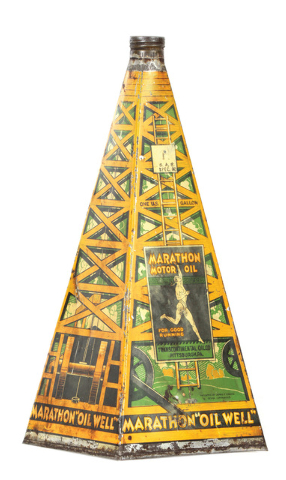Vintage motor oil cans come in many shapes, sizes
One of today’s most popular collectibles for automobile enthusiasts is a vintage motor oil can. There is very little information available about the cans, but there’s a lot about the companies that made the oil. So it’s easy to date a can by its logo and style, which makes it easy to find great early examples.
The tin can was invented in 1810 to hold food for Napoleon’s army. Cans were made by hand in the early 19th century. About six could be made by one man in an hour.
By 1900 the main products stored in tin cans were food and petroleum products. Cans made around the turn of the 20th century had a soldered seam on the side that looks like a gray strip.
Cardboard cans were introduced in the 1940s but were widely used from the 1950s to the 1980s. The first soft drink aluminum cans were used in 1953. The first aluminum cans for motor oil were made in 1958. The square cardboard quart oil can came into use in the 1960s.
Most popular with collectors are the quart size, then the gallon, then the 5-gallon, and it does not matter if the can is full or empty.
An unusual Marathon motor oil container sold in 2014 at a William Morford auction. It’s shaped and decorated to look like an oil well. The 15-inch-high can has the brand’s “Running Man” logo, a silhouette of an ancient Greek runner and the slogan “Best in the long run.” The logo dates to the 1920s, but the brand was purchased by the Ohio Oil Co. in 1930.
Q: I have a New York Mets pennant from the 1969 World Series. It’s red with white and blue lettering that reads “New York Mets, 1969 National League Champions.” It has the Mets logo, Mr. Met, and the words “World Series.” The last names of all the players and the manager are listed. The pennant is in good condition. What is it worth?
A: The New York Mets were an expansion team that ended up in last place in 1962, its inaugural season, and second to last the following seasons until 1969, when they clinched the National League pennant. The “Miracle Mets” upset the Baltimore Orioles and won the World Series that year, too. Mets pennants like yours in good condition sell for about $50 to $100.
Q: We have a Fleischmann’s model steam engine that’s 9½ inches tall. It’s in a box marked “Fleischmann 105/1” and “Western Germany.” There also are operating instructions. We can’t find a date or any other information, but it seems to be an old toy. Can you give us any information about this model?
A: Jean Fleischmann founded his toy company in 1877 in Nuremburg, Germany. The company began making steam toys after World War II. Model steam engines were made to power model trains and other toys.
Fleischmann was taken over by Modelleisenbahn (Model Railways) in 2008 but continues as a separate brand. Your model steam engine was made anywhere from 1950 to 1964. The steam engine sells for under $50.
Q: My small Victorian “parlor table” is made of oak. It has a shaped top and intricately turned legs and four little claw feet, each holding a little glass ball. I cannot find a mark or label. What would the table sell for today?
A: Those glass ball-and-claw feet were popular during the Victorian “Golden Oak” period of furniture-making. If your table is in excellent condition, it could sell for $300 or more.
Q: I have a deck of playing cards with pictures of Iraqi dictator Saddam Hussein, and his henchmen. The joker lists the ranks of Iraqi military next to ranks of the U.S. military. Can you tell me anything about these cards and their value?
A: A set of “personality identification playing cards” like yours was developed in 2003 to help members of the U.S. military identify “wanted” Iraqi government officials and party chairmen. Each card had the person’s picture, if available, his or her last known location, and their government or committee position.
High-ranking officials were pictured on the aces and face cards, and less important people on low-number cards. Saddam Hussein was pictured on the highest-ranking card, the ace of spades.
The day the deck of cards was announced, an enterprising civilian downloaded the images from the U.S. Defense Department website and offered them for sale on eBay. Soon other people also were selling the cards. Decks of Iraqi Most Wanted Playing Cards have sold online for $5 or less.
Q: In the 1970s, I was a salesman for Wilson’s tennis equipment. I recently uncovered long-forgotten boxes of unused tennis rackets from the days when Wilson was far and away the leading manufacturer of rackets. The rackets are in perfect condition.
Most of them have never been strung and most also come with a cover. Is there a market for these?
A: There is a market for vintage tennis rackets, although competitive players would never use them today — technology has improved rackets too much. You should contact a dealer or auctioneer who specializes in sports collectibles.
And organize your collection and any related printed material to prove the age of each model. It is likely that a single racket could sell for $25 to $50.
Tip: Check wires and screw eyes before hanging an old picture.
Terry Kovel’s column is syndicated by King Features. Write to: Kovels, (Las Vegas Review-Journal), King Features Syndicate, 300 W. 57th St., New York, NY 10019.

















